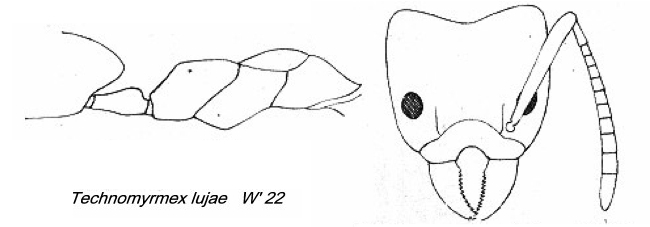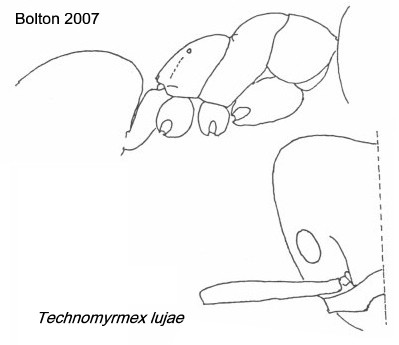Technomyrmex (Engramma) lujae (Forel)
  Type location Zaïre (Engramma
Lujae n. sp., Forel, 1905b: 181, worker & male), combination in
Technomyrmex
by Shattuck (1992b) - see below Type location Zaïre (Engramma
Lujae n. sp., Forel, 1905b: 181, worker & male), combination in
Technomyrmex
by Shattuck (1992b) - see below
junior synonyms
pulliceps (Santschi,
1926b: 244, worker) from Zaïre - see below
wasmanni (Engramma
Lujae For. r. Wasmanni
n. stirps, Forel, 1916:
432, worker, queen & male) from Zaïre, collected by H Kohl - see http://www.antweb.org/specimenImages.do?code=casent0909757
griseopubens (Engramma griseopubens, Wheeler,
1922: 206, illustrated, worker) from Zaïre - no images on Antweb (April 2015)
synonymies by
Bolton (2007: worker and male only described (Bolton, 1995)  . .
|
 Forel's (1905b) description is at Forel's (1905b) description is at  , with the male at , with the male at  . Forel's (1916) description of wasmanni
is at . Forel's (1916) description of wasmanni
is at  . .
Forel (1911f) reported Engramma lujae from
Zaïre, Kasai, Kondué by Luja. Santschi (1926b) noted pulliceps
differed from the type by the darker colour of the head, which is a
reddish brown; the antennae are as dark as the legs; the occiput is a
little less impressed.
Wheeler (1922, with the illustration) noted - "a single
worker of this species was found among the numerous specimens of the
preceding species (kohli) and was taken in the leaf-pouches of Scaphopetalum
thonneri at Niapu. I have compared it with a cotype of lujae
received from Prof. Forel and represented in the accompanying figure.
Bequaert (1922, p 420), however, also reported finding it in leaf
pouches of Scaphopetalum dewevrei at Kondué".
|
 Bolton's
(2007) re-description is at Bolton's
(2007) re-description is at  . This is the Technomyrmex
sp. 2 of Watt, Stork & Bolton (2002), comprising 80% of the canopy
ants on Terminalia ivorensis. . This is the Technomyrmex
sp. 2 of Watt, Stork & Bolton (2002), comprising 80% of the canopy
ants on Terminalia ivorensis.
Note The Bolton
illustration, with a smoothly rounded propodeum profile matches the
Wheeler drawing of griseopubens,
whereas the fresh worker from the Central African Republic in the photomontage below has the angular
propodeum of Wheeler's lujae.
The head shape and proportions of the clypeal notch also differ in the
same pairing.
|

Technomyrmex (Engramma) griseopubens (Wheeler)
Type location Zaïre (Engramma griseopubens,
Wheeler, 1922: 206, illustrated, worker), combination in Technomyrmex
by Shattuck (1992b); worker only described (Bolton, 1995)
Wheeler (1922, with the illustration) described it as
follows -
WORKER - Length 2.7 mm. Head without the mandibles slightly longer than
broad, much broader behind than in front, with somewhat angularly
excised posterior border and feebly convex sides. Eyes small and flat,
in front of the middle of the head. Mandibles rather large, convex,
their long apical margins with numerous crowded denticles. Clypeal
notch semicircular, about one-fifth as broad as the anterior margin.
Frontal carinae somewhat closer together than to the lateral margins of
the head. Frontal area and groove obsolete. Antennae rather slender,
scapes not reaching to the posterior corners of the head; first
funicular joint twice as long as broad, remaining joints except the
last, as broad as long. Thorax with sharply marked promesonotal and
metanotal sutures, the pro- and mesonotum forming a hemispherical mass,
the latter circular, the humeri rounded; the metanotal constriction
moderately deep, acute; the propodeum lower than the promesonotum, only
a little longer than the mesonotum, broader than long, in profile
rather convex, sloping, without distinct base and declivity. Petiole of
the usual shape, elliptical, with its anterior border thickened above
as the vestige of the node. First gastric segment overlying the petiole
as in the other species of the genus; anus nearly terminal. Legs rather
slender.
Shining; whole body very finely and uniformly punctate. Hairs absent,
except on the mandibles and tip of the gaster, where they are very
short. Pubescence gray, short and fine, rather abundant, uniformly
covering the whole body, but not concealing the surface. Black;
mandibles, sides of clypeus, cheeks and gula brown.
Described from a single specimen taken by Lang and
Chapin on firewood between Lukolela and Basoko. This species is quite
distinct in the shape of the thorax, in sculpture, and in pilosity.
|